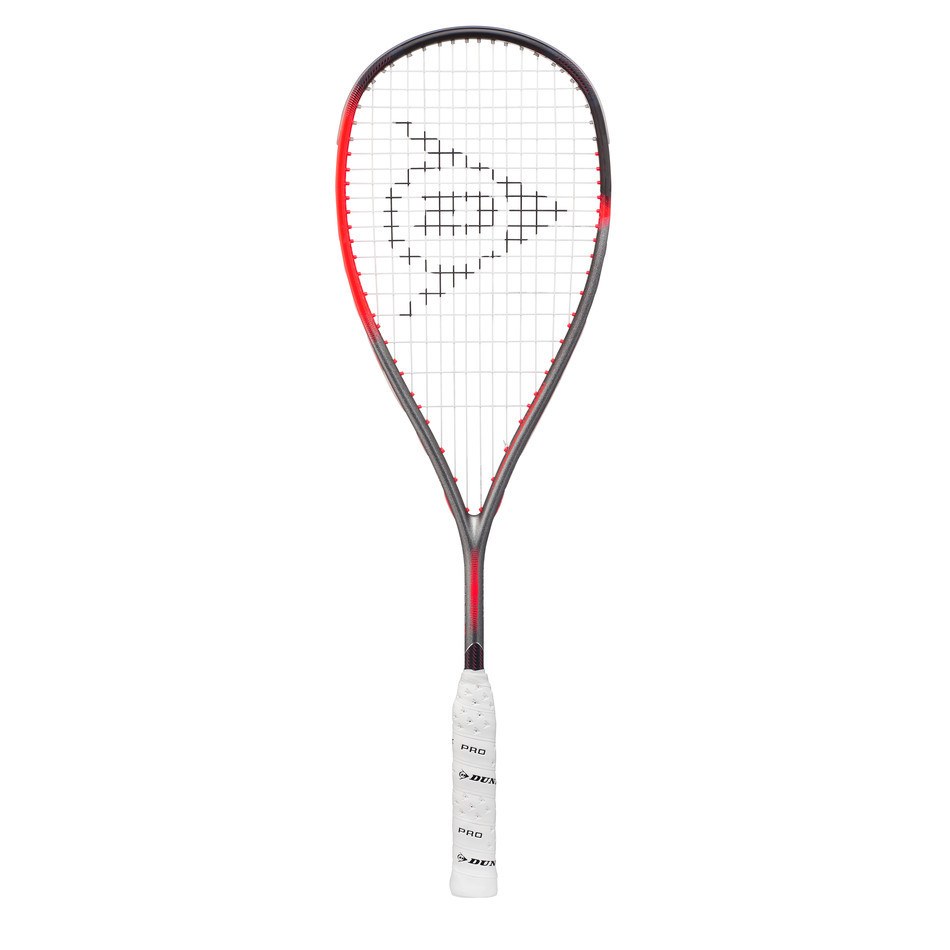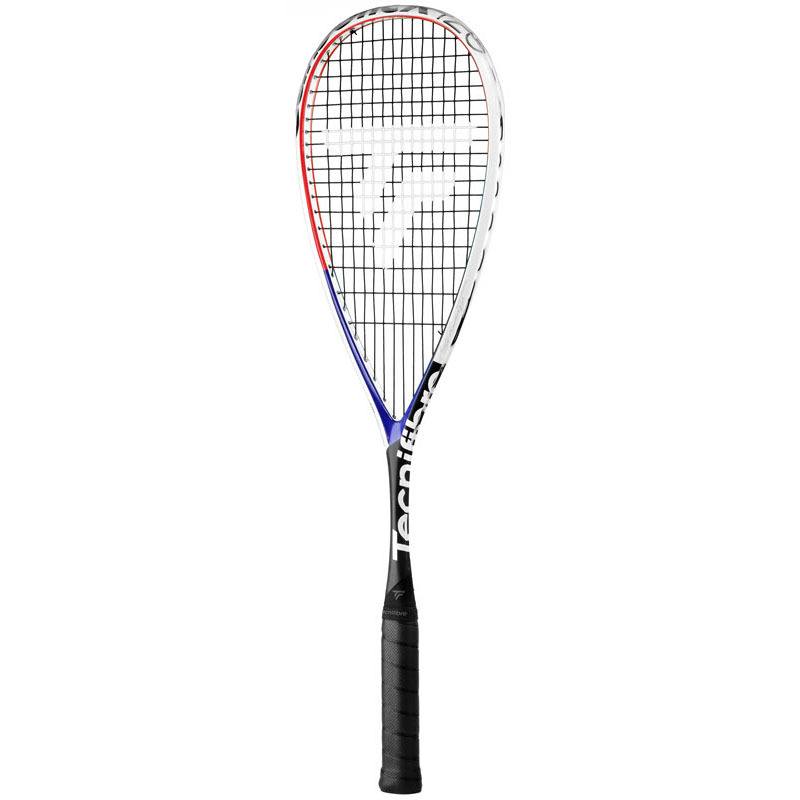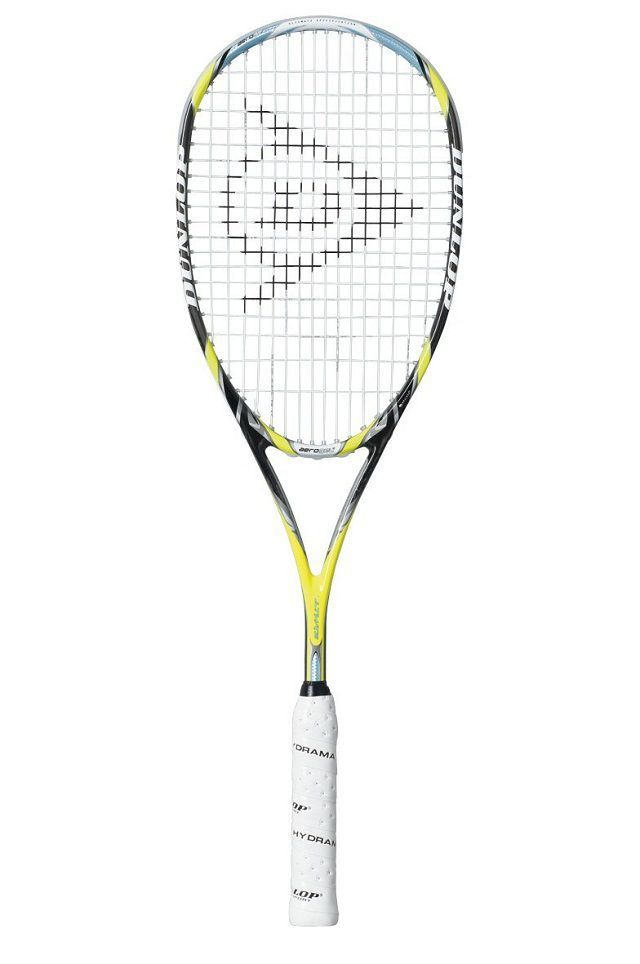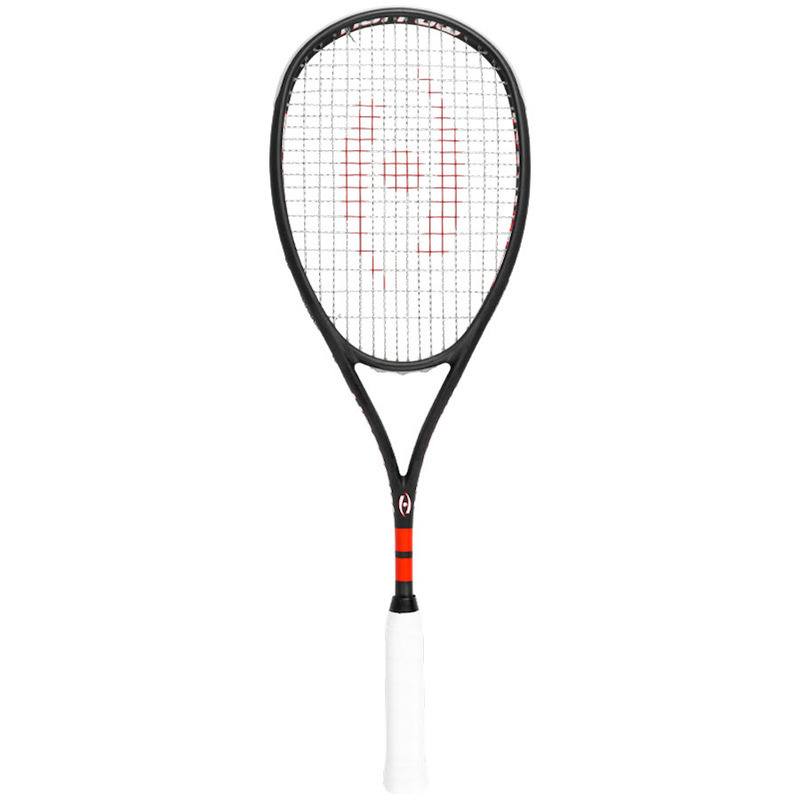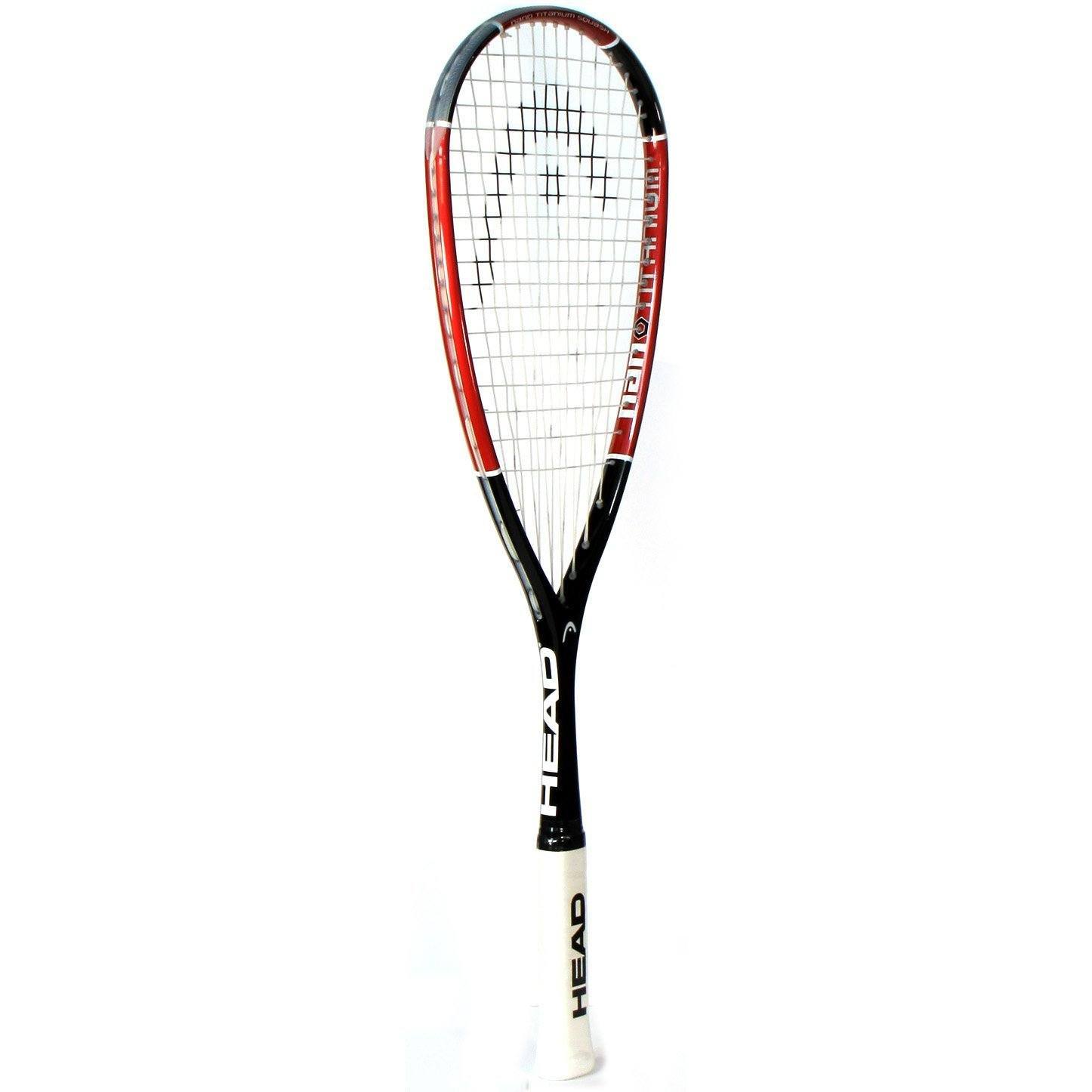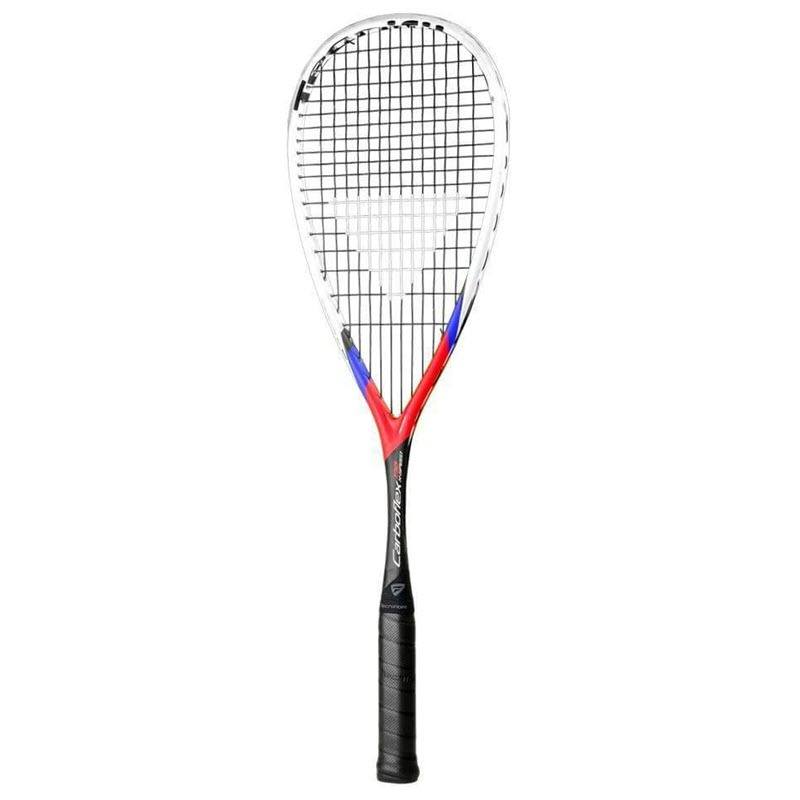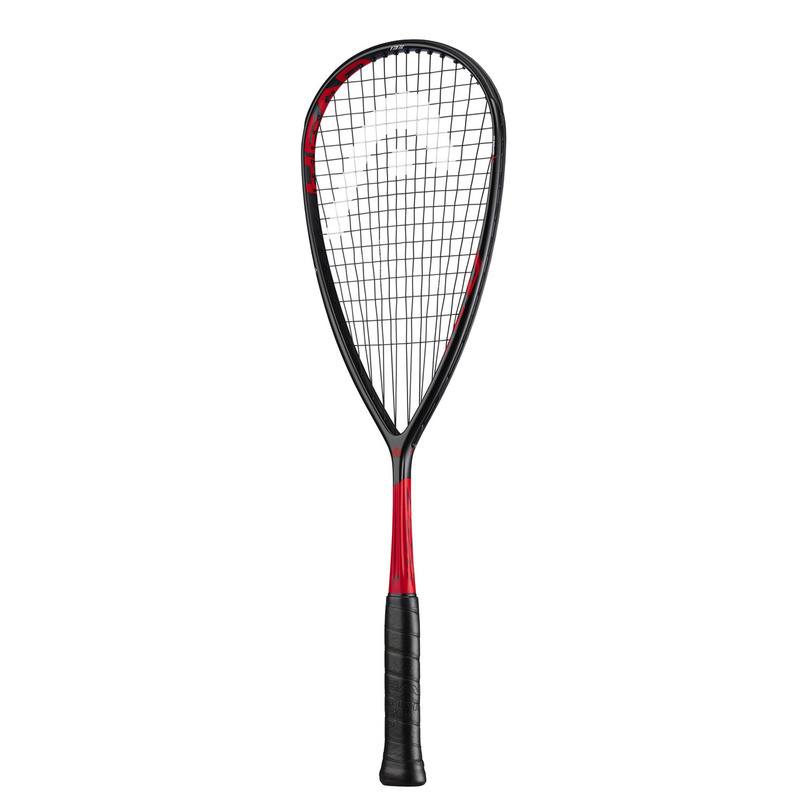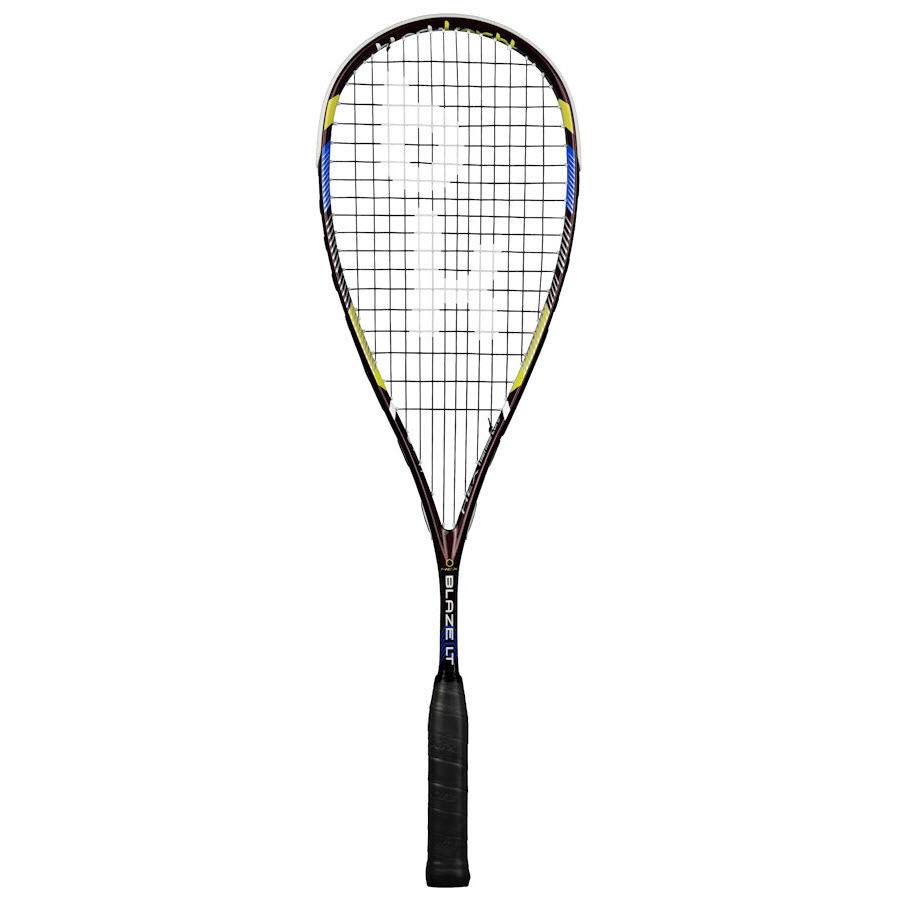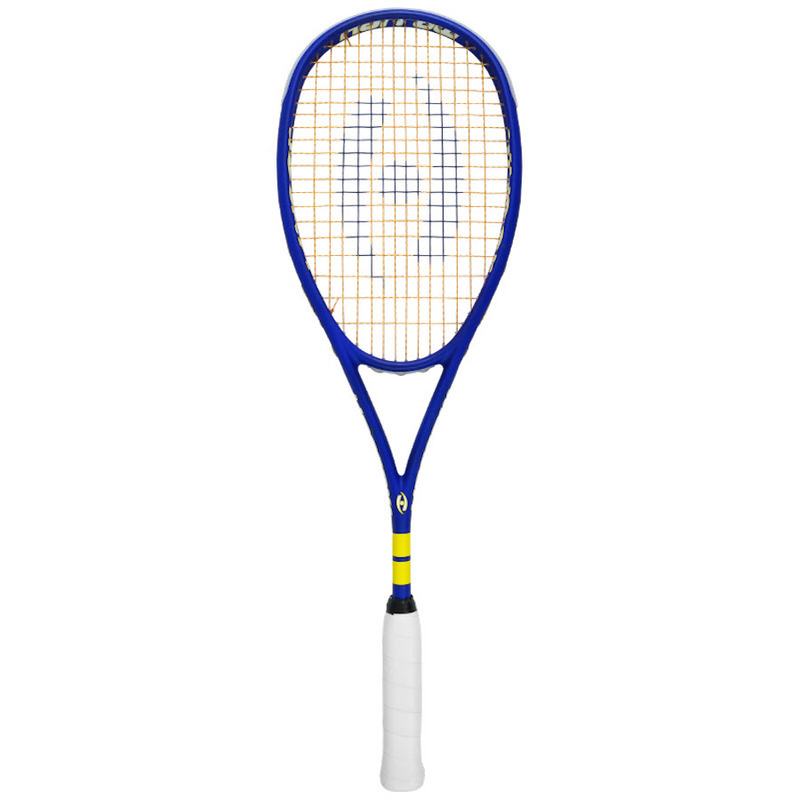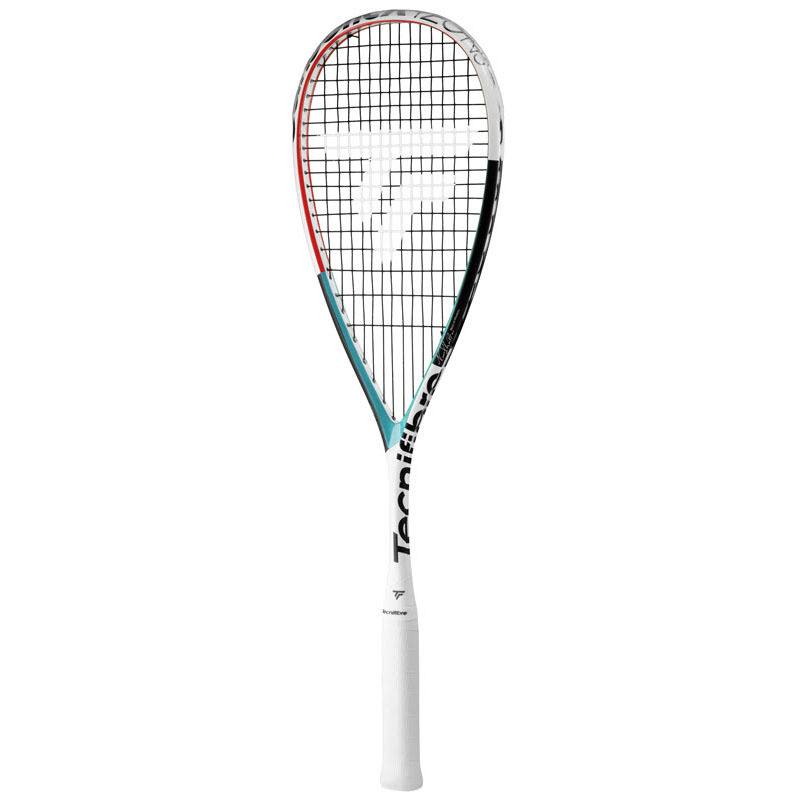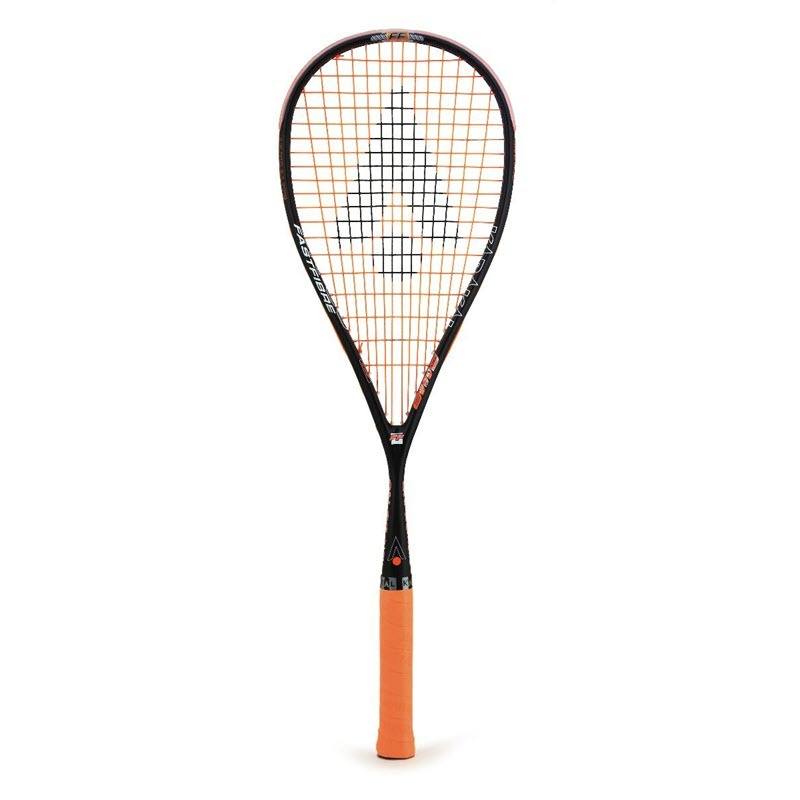When getting ready to play a game of squash, by far the most popular and obvious piece of equipment necessary is the racket, though it is easily not the simplest in terms of figuring out which are the best squash rackets for your style of game and skill level.
In fact, the sheer number of options and approaches can be incredibly daunting if you are not intimately familiar with what each of the individual qualities means.
Best Squash Rackets
Still, figuring out which is the best squash racket for your needs can be a difficult and confusing task. That is why we have put together a list of the 9 best squash rackets, highlighting what each one does best. Then we provide a helpful buyer’s guide, so you can find the best squash racket for you.
1. Dunlop Hyperfibre XT Revelation Pro Lite
Best Overall Squash Racket
Release year: 2019
Price: $150
Racket Specs
- Advertised weight (unstrung): 125 grams
- Head size: 490 cm sq
- String pattern: 14×19
- Measured weight (all-in): 151.5 grams
- Measured balance: 36 cm
My pick for the best overall squash racket is the Dunlop Hyperfibre XT Revelation Pro Lite. Dunlop came out with this around 2019. I played with this racket myself for about a year, just before the pandemic hit, and several top pro players used this racket as well.
This racket has a teardrop head shape with a fairly even balance point.
I like the teardrop shape because the longer string bed gives you a little more power and is a bit more forgiving. Because of that, I had to make my top overall pick a teardrop, but I’ve got a recommendation below for a traditional head shape option if you prefer that.
I mentioned this racket has an even balance point. I think that’s a good starting place for most players. There’s another version of this racket called the Revelation Pro that current world #1 Ali Farag uses but the reason I haven’t recommended that one (and the reason I didn’t play with that one myself) is it’s just too head heavy. It feels like a brick in your hand. Honestly I don’t even know how Ali Farag and his tiny forearms can even swing that racket, much less win tournaments with it.
As far as the price point, this racket is a good deal right now at $130 in the US and a VERY good deal in the UK at £60. Part of the reason it’s a good deal is that Dunlop has come out with a newer model, the Dunlop Sonic Core Revelation Pro Lite, replacing the Hyperfibre XT model. Whenever a new model comes out like that, the previous one gets priced at a discount because it’s not the latest-and-greatest, but that doesn’t take away the fact that the prior model is a high quality stick.
One last thing I want to say about this choice is I picked it in part because Dunlop has good worldwide distribution. You can get this racket in North America, UK / Europe, and Asia. I didn’t want to pick one that you’d have to order from overseas, as much as possible.
2. Tecnifibre Carboflex Airshaft 125
Top Squash Racket on the Pro Tour
Release year: 2020
Price: $220
Racket Specs
- Advertised weight (unstrung): 125 grams
- String pattern: 14×18
- Measured weight (all-in): 153.1 grams
- Measured balance: 36.25 cm (54% in the head)
Alright, you’ve heard my opinion on the best all-around squash racket, but which racket is best in terms of popularity amongst professional squash players on the PSA World Tour?
Right now, I’d say that title goes to the Tecnifibre Carboflex Airshaft 125. It’s used by Mohamed El Shorbagy and at least ten other top pros, on both the men’s and women’s tours.
Here’s the thing.
This particular series of rackets has been hugely popular for years. It started with the original Carboflex 125, which is still in print but now known as the Tecnifibre Carboflex 125 Heritage.
It’s gone through several iterations since then, and the latest model is the Airshaft 125. Because this is the latest-and-greatest racket that the top pros are using, it’s also one of the more expensive rackets on the market. In the US right now it’s $220, and in the UK it’s a slightly more affordable £130.
If you want to get a taste of what this racket is like, without paying top dollar for the latest model, you can try the previous version, called the Carboflex X-Speed 125. Shorbagy and all the other Tecnifibre pros used that racket pre-pandemic.
3. Dunlop Aerogel 4D Ultimate
Best Squash Racket on a Budget
If you’re looking for a lower-cost option, I would try the Dunlop Aerogel 4D Ultimate. “Aerogel” is a technology that Dunlop used in their rackets maybe ten years ago. While the technology’s a bit dated, they are still good quality rackets. These frames were top of the line at the time, and many of the Aerogel frame shapes are still in wide use today.
Dunlop still seems to be keeping the Aerogel Ultimate model alive, which is a good thing for budget-seekers everywhere.
There’s a newer iteration of the Ultimate called the Dunlop Sonic Core Ultimate. It’s got the same frame shape and stringing pattern as the old Aerogel model. It might have some incremental improvements in materials over the Aeorgel Ultimate, but it’s still pretty similar.
If you want a budget-friendly alternative though, stick with the Aerogel version. There’s also an Aerogel Elite that I’d recommend for the same reasons.
4. Harrow M-140
Best Hardball Doubles Squash Racket
My personal favorite hardball doubles racket is the Harrow M-140.
Harrow is certainly the top brand in the doubles space and has been for years. I believe the M-140 is one of the top-selling Harrow rackets and one of the most popular amongst pros on the doubles pro tour.
I like it for a few reasons.
- Medium-size head. While a larger head would seem more forgiving, actually any off-center hits in doubles are going to result in a poor shot. I think you’re better off with a slightly smaller head and gaining the extra control.
- Dense string pattern. This is another important factor for me in being able to control the harder doubles ball. An open string pattern allows you to put more cut on the ball but that’s really more applicable to a (softball) singles situation.
- Concave frame. The M-140 has a concave shape, as opposed to a convex one, at the point where the grommets pass through the frame. In my book this makes the racket stiffer, which is another important factor in being able to control a fast-moving doubles ball.
5. Head Nano Ti 110
Best Squash Racket for Beginners
Racket Specs
- Advertised weight (unstrung): 110 grams
- Head size: 493 cm sq
- String pattern: 14×18
- Measured weight (all-in): 149 grams
- Measured balance: 37 cm
If I had to pick one off that list, it would be the Head Nano Ti 110. One thing I like about this one is its teardrop shape. That will give you a little extra power, and the racket will be a little more forgiving. I use a teardrop myself and have been playing with them for years, and I definitely recommend them for beginners as the default option.
Another nice thing about this model is it comes with a fan stringing pattern (the strings fan up and outward from the throat). I find that that stringing pattern provides a little additional power, which is useful when you’re getting started.
While the Nano Ti is one of Head’s older models, the build quality is still good, and the cosmetics are also nice.
Bottom line, this is a good starter racket that looks and plays like a high-end model, but without sporting a high-end price.
6. Tecnifibre Carboflex X-Speed 130
Most Durable Squash Racket
Racket Specs
- Advertised weight (unstrung): 130 grams
- Head size: 500 cm sq
- String pattern: 14×18
- Measured weight (all-in): 157 grams
- Measured balance: 36.5 cm
If you’re looking for a durable racket, I’d recommend the Tecnifibre Carboflex X-Speed 130. Recommending a high-durability racket is a bit tricky because any racket can break if you clip the sidewall or the floor a little weirdly. There’s always the possibility of a freak accident like that, even among players with a high level of racket skill. And of course the risk is higher for beginner or intermediate players.
That said, right now, I would say Tecnifibre is the brand with the best reputation in terms of durability. That’s my gut feel from talking to squash players and reading the Squash Source comments.
Granted, that’s not very scientific, but it’s the advice I would give right now to anyone who asked me.
The reason I picked the X-Speed 130 model specifically is because it’s 5 grams heavier than the X-Speed 125, and that’s 5 extra grams of graphite holding the frame together. I know it’s just a small difference, but every bit helps.
7. Head Graphene 360 Speed 135
Best Squash Racket for Power
I already mentioned the Head Nano Ti as a good beginner racket and it meets the string criteria I’m laying out here, but just to throw out another option, I’ll mention the Head Graphene 360 Speed 135
There are two ways to look at generating power with a squash racket. If you’re more of a beginner or intermediate player, you want to get a racket with a larger string bed and a fan stringing pattern. The strings on that kind of racket are just going to produce a little more ‘pop’ on your shots.
Racket Specs
- Advertised weight (unstrung): 135 grams
- Head size: 500 cm sq
- String pattern: 12×17
- Measured weight (all-in): 156.5 grams
- Measured balance: 35 cm
The 360 Speed 135 has the teardrop frame shape and fan stringing pattern. It is essentially a more recent version of the Head Nano Ti, and with even nicer cosmetics too.
The other way to generate power with your squash racket is by developing a faster swing speed. That’s going to be for the more advanced player, because you need to have your swing timing down in a really controlled manner.
For the advanced player I’m going to recommend the Black Knight Hex Blaze LT:
Racket Specs
- Advertised weight (unstrung): 130 grams
In my testing the Hex Blaze LT felt very light in the hand, with a slightly head heavy balance. This allowed me to get a lot of power behind the shots because you can swing through the ball quickly, but without losing control of the racket.
This racket also comes pre-strung with a premium string, the Supernick ZX Micro, which adds to the power of the frame.
8. Harrow Vapor
Best Squash Racket for Control
For the most control, I’m going to recommend a traditional head shape racket, the Harrow Vapor.
I generally recommend a traditional head shape for control because the bridged throat makes the racket more stable through the shot. In other words the racket is less likely to wobble as you make contact with the ball.
While a teardrop racket is nice for additional power, that comes with a little more unpredictability on the shot. For greater precision I like the bridged throat of a traditional head shape.
There are two more qualities of the Harrow Vapor that I feel offer additional control.
First, it has a slightly smaller string bed than some of the other traditional-head-shape rackets out there.
Second, the Vapor has a slightly stiffer frame than many other rackets with traditional head shapes.
Both of these features give the racket more predictability in terms of your shotmaking, thus additional control.
9. Tecnifibre Carboflex Airshaft 125 NS
Best Squash Racket for Women
Racket Specs
- Advertised weight (unstrung): 125 grams
- String pattern: 14 x 18
- Measured weight (all-in): 156.2 grams
- Measured balance: 36.25 cm (53% in the head)
- Factory strings: Tecnifibre DYNAMIX V.P. 1.25
I’m going to mention a racket for women. Most of the time, women just use the same rackets as men. Any racket mentioned on this page is a good choice for both men and women.
For a while, some manufacturers were trying to market squash rackets to women just by making a pink version of a racket that was already in their lineup. Of course that works for some players, but obviously it’s just cosmetic and not a meaningful difference.
Enter the Tecnifibre Carboflex Airshaft 125 NS. This is world #1 Nour El Sherbini’s racket (hence the “NS” in the name). The 125 NS actually has a difference compared to the regular Airshaft 125:
It has a smaller grip.
A subtle change, but an important one.
Obviously this works for anyone with smaller hands, or anyone who just wants a smaller handle. It doesn’t have to be for women. And the cosmetics, mercifully, are not pink.
I’ve tested the Airshaft rackets myself and I actually prefer the smaller grip of the NS over the normal-sized grips of the other Airshaft models.
10. Karakal SN-90 FF
Lightest Squash Racket
The lightest squash racket on the market is the Karakal SN-90 FF, with an advertised frame weight of 90 grams. I’ve never actually played with this racket myself, just wanted to include it for the curious-minded.
The SN 90-FF is the successor to the SN 90, which came out about seven years ago.
The Ultimate Best Squash Rackets Buying Guide
For those buying their first racket, or looking to upgrade their existing one, there are a number of key factors to consider before making a final choice, although, essentially they offer a trade-off between power and control.
Weight
Squash rackets typically weigh anywhere between 110 grams (3.88 ounces) and 190 grams (6.70 ounces).
In part, the choice is determined by the style of the player. The faster, more aggressive player will tend to opt for the lighter racket because they can impart more control and change of direction on the ball with it.
By contrast, those with a slower swing will prefer a heavier racket, because they can hit the ball harder, and make their opponent do more of the running.
The age and size of the player also needs to be a consideration. Junior, and smaller players are better suited to a lighter racket.
It should be noted that the advertised weight of a racket does not include accessories like the strings and the grommet (the plastic strip that runs along the inside of the racket, and which helps protect the strings).
Balance
Balance is important because the weight of the racket is not always even distributed, in most cases deliberately so, based on the shape, size, material used and the way that the racket has been manufactured. There are basically three options when it comes to balance:
Head Light
This is suitable for players who like to volley a lot, and who enjoy flicking the ball. It is also suitable for players with strong upper body strength.
Head Heavy
These are designed for players who like to hit the ball harder with a bigger swing.
Balanced Racket
These have the weight distributed evenly and offer both manoeuvrability and power, without the extremes provided by the other two.
Strings
Squash racket strings differ by material, texture and tension, and how these factors combine makes a world of difference as to how the game is played.
Whilst most rackets are sold pre-strung, using fairly basic strings, experienced players may prefer to get them re-strung immediately so they are adapted to their style.
Strings are usually made of nylon, although some manufacturers use composite materials and polymers which impart other performance characteristics.
A monofilament consists of a single, heavy nylon fibre, which is durable, but can be quite stiff offering less control.
Alternatively, there are multifilament cores made up of very thin fibres twisted together. They have a soft, resilient feel, and help the player maintain control but, on the downside, they are prone to snapping, and need to be replaced more frequently.
String tension is also a key consideration. As a general rule, the higher the tension, the less power generated, but the more control which can be exerted.
Throat
Squash racket throats fall into two generic types – Open throat (teardrop style) and Closed (bridged) throat.
Open Throat
With this type of racket the strings run all the way down to the shaft, allowing the bed of the strings to move more freely. These rackets have a bigger surface area and sweet spot, and are more powerful because the strings have more area to work in and provide velocity to the ball.
There are drawbacks, however.
One is that the player has less control over the ball because when the strings flex and snap back, they do not do so in perfect alignment every time. Also, the teardrop head means that the frame is less stable than the alternative.
Closed Throat
Rackets with a big opening in the throat area – often called a bridge – offer better control because of the shorter length of string.
The reason is that when the string springs back it does so with less force. However, by the same token, the smaller string area means that less power can be generated.
Beam and Grip
The beam (width) of a squash racket generally varies between 16 mm (0.63 inches) and 21 mm (0.83 inches).
Generally the thinner beams are reserved for expert players, whilst the thicker beams are more appropriate for the less skilled. The thinner the beam, the greater the degree of control and angles which can be put on the ball.
Grips come in a standard size. However, it is easy to alter them by adding overgrips to suit the size of a player’s hand, or their style of play.
Price
I know I have put something as important as the racket price so low in the list but if you are a serious player you would want to consider the other factors before you jump into the price.
Squash rackets vary tremendously in price, and if budget is the key factor, then a basic racket can be picked up cheaply.
However, buying cheap is unlikely may be a false economy because it may not suit the style of the player, and may need to be replaced in a matter of months.
It is better, money allowing, to consider all the factors above, and then for the prospective purchaser to buy one that suits their game, and level of skill and expertise.
Buy Best Squash Rackets FAQ
What is a good weight for a squash racket?
Squash rackets come in ranges from 90kg to 180kg. The average weight is 130kg. You want a lighter racket if you a more aggressive, strong hitting player. A heavier racket will help players with a slow or weak swing generate more power with the heavier squash racquet weight.
What are squash rackets made of?
Graphite is the dominant material squash rackets are made of. This allows the racket to be lightweight but durable. Aluminum is another material used to make squash rackets. We do not recommend using an aluminum squash racket.
When should I restring my squash racket?
What consistently needs updating is your squash racket strings, which should be replaced on an annual basis.
Can you play with a broken squash racket?
Playing with a broken squash racket is a bad move. You may be tempted to try and tape it back together. The best bet is to just throw the racket away. At a club in my city, they hang broken rackets on the wall for nostalgia!
When I break my frame, I know it. I can feel the weight is off on a swing follow through and know that it is time to grab my backup racket (always have at least 2 squash rackets)!
What if I break the racket strings?
If you break your strings, you will want to get your racket restrung. This will run you roughly $30 due to the cost of materials and labor. If your club restrings rackets, just drop the racket off. Most tennis shops will also string squash rackets and are familiar with how to string them, even if they do not sell squash rackets in their tennis store.
What are the best squash racket strings?
We like the Ashway Supernick XL or the Tecnifibre 305+. For stringing your racket, it depends on if you are playing singles or doubles squash. You will need about 10 meters of string to restring your squash racket strings. You can strings individually or in bulk.
- Singles Racket String Tension: String your tension at 26-28 pounds (more power at lower tensions)
- Doubles Racket String Tension: String your racket tension at 27-29 pounds (more control at higher tensions)
Conclusion
As you can see, there are several factors that go into making a racket “best” for you as an individual player. As a result of your play style and physical attributes, one racket may suit you better than the next player.

